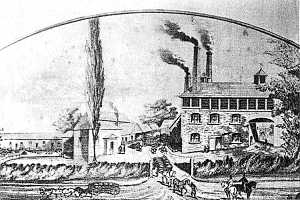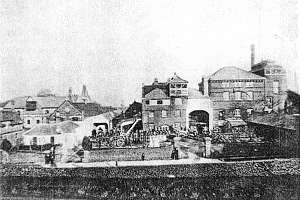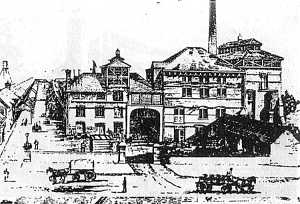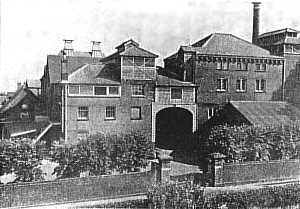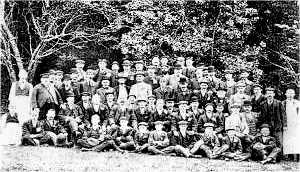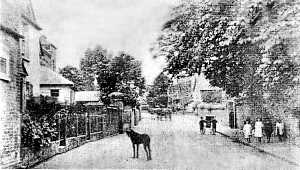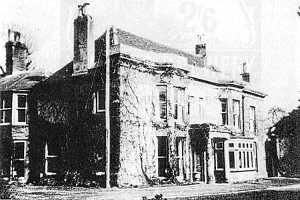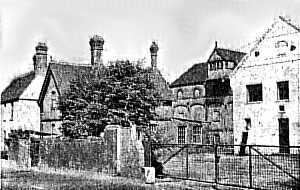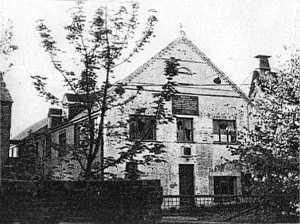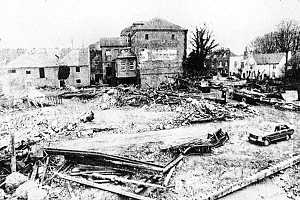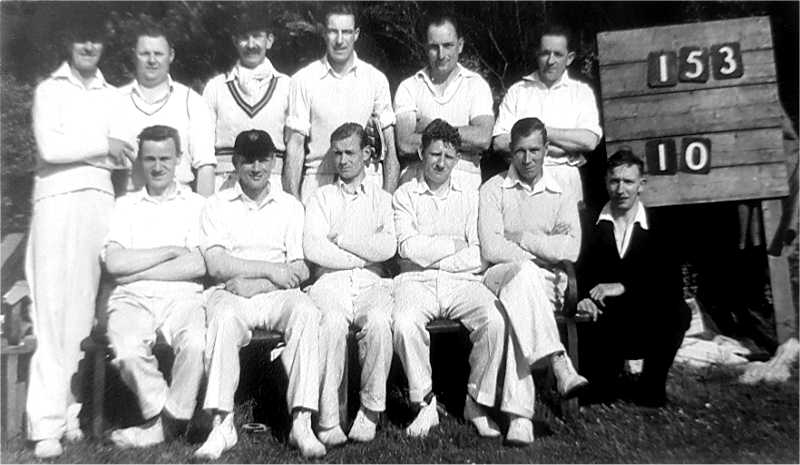Although no firm evidence appears to exist, it is widely believed that Upper Walmer was home to a brewery from Tudor times and possibly earlier. It certainly seems that there was already a small brewery on the Dover Road just south of the old Walmer Village and that in 1816 this was acquired by Edmund Thompson who then operated it as Thompson & Sons. In 1867 John Matthews bought the business and greatly expanded and modernised it, although he retained the Thompson Brewery name.
The maltings, bottling plants, brew house, stables and blacksmith's eventually covered a very large area in the village and were an important local employer. Further houses were bought in Dover Road for use as offices and to house staff, and a long terrace of brick cottages was built in Belmont to house more workers.
During the 1950s, the brewery became part of the Charrington's company and its role reduced to a bottling and distribution plant. It eventually closed in 1972 and was demolished in 1978 to make way for a housing development at Downlands. The old bell once housed in the belfry at the brewery was re-sited at the Thompson Bell, the last remaining public house in the village.
Thompson's Walmer Brewery
It is said that the funds that enabled Edmund Thompson to acquire and develop the brewery at Walmer in 1816 were from a family fortune derived from the dubious exploits of Captain Richard Thompson attacking a Spanish galleon and holding the crew prisoner for a substantial ransom.
Unfortunately, the early records of Thompson & Sons were lost in an office fire in 1820, so much of the early history of the brewery must be speculation, as stated by the authors of The Deal and Walmer Illustrated Guide published in 1897. They wrote:
"Although there is no evidence of this brewery having been in existence prior to the date mentioned, we cannot but think that Walmer must have boasted a similar establishment, on a smaller scale, at some anterior period, and that Mr Thompson's more important organisation was designed to replace and enlarge upon the latter.
"The brewery buildings cover a large area of ground in the picturesque village of Upper Walmer. They are approached from the main Dover Road by means of a wide gateway, with public and private offices on the left; and the entire range of premises, mostly of quite modern construction, has been admirably planned throughout; strict cleanliness and good order being distinctly observable features in each spacious department. Plant and appliance, too, even to the smallest minor details are of the latest improved kinds, and necessarily equal to an extremely large regular turn-out. In fact, the firm's well known trade mark, the South Foreland Lighthouse, on either bottled or draught ales or stout, may always be looked upon as a distinct guarantee of purity and excellence."
As with the other East Kent breweries at that time, Thompson & Sons had a distinctive range of ales and stout. The authors of the Illustrated Guide sang their praises:
"The A.K.S. Bitter Ale will be found a particularly well flavoured tonic ale for general use; whilst the A.K. cheaper ale, and the celebrated India Pale Ale are both of excellent quality, clear and bright to the last. The latter as well as Pale Ale, Light Dinner Ale, Stout and Cooper are also obtainable in fine condition in screw topped bottles. The other productions of the Walmer Brewery consist of X, XX and XXX Ales of varying strengths, Double Stout and Porter; whilst the firm also bottle large quantities of Bass's Ales in the best possible condition."
With the acquisition of the brewery in 1867 by Mr John Matthews (formerly the senior partner in Matthews and Canning of The Anchor Brewery in Chelsea, London) the operation expanded and he had new maltings built. By 1897 the brewery was under the management of Mr Arthur J. and Mr William P. Matthews who had succeeded John Matthews.
Two years later Thompson & Sons had acquired the only other similar establishments in the area, that of Messrs Hills of Deal and Great Mongeham. Hill's brewing operations were transferred to Walmer and their "tied" public houses taken over and added to the Thompson's chain.
The Brewery in World War One
When the First World war broke out Army mules were housed in the former brewery stables. It is said they would regularly escape and go trotting off down the road until rounded up. The stables had been erected for the heavy 'draught' horses used to pull the delivery carts known as 'drays'.
However, in 1912 Thompson & Sons acquired a Sentinel steam wagon for deliveries to their outlying 'tied houses' and, when horses were requisitioned by the Army in 1916, they acquired another similar vehicle. These were replaced post-war - possibly about 1930/31 - with motor lorries and the proprietor of a local garage in Station Road was quickly recruited to teach the "steam drivers" how to handle their new vehicles.
Between the World Wars
One recollection of life in Walmer during the 1920s comes from Dick Game, whose father was then the Head Brewer at Thompson's Brewery. He remembered that the smell of beer pervaded the whole area and its tall chimney was visible for miles. Employing seventy people, who in turn supported the shops and local businesses, the brewery never closed, although work stopped on the whistle. Dick's family lived at King's Cottage on the Dover Road on the southern edge of the village. Opposite the brewery were terraced houses, the end one occupied by Major George Matthews and his wife whilst the company secretary Mr Taylor and his wife and three grown-up daughters lived next door. Dick Game recalled:
"As you went through the main gates of the Brewery, on the right was the cask washing. Hot water and steam, men in clogs and leather aprons washing our Hogsheads (51½ gallons), Barrels (35 gallons), Kilderkins (18 gallons), Firkins (9 gallons) and Pins (4½ gallons). On the left was the office, a single storey building with big windows, while behind that was the bottle store, where the women worked and machines filled bottles with different beers, and then labelled them."
The site's malt house was a long low building with small shuttered windows where men with wooden shovels turned the sprouting barley. As the single main employer in the village, the owners of the brewery held strong influence over the lives of their workers. For example when there was a General Election the brewery was decorated with the local Conservative Party orange and purple colours and it wasn't a wise move to voice opposition and risk losing your job or house.
Brewery owners and brothers, William and Arthur Matthews both lived near their brewery.
Mr and Mrs 'Willie' Matthews occupied the Old House, facing the brewery on the Dover Road but later demolished and now the Thompson Close estate. (Correction: We have been advised that the Old House was located behind the old brick wall in front of numbers 373 and 375 Dover Road, just to the south of the entrance to St Margaret's Drive.)
Mr and Mrs Arthur Matthews and their daughter, Miss Eileen Matthews, lived in The Shrubbery, also on the Dover Road. A large house set in substantial grounds next to the "Convent of the Visitation", it stood on the site of an older property once occupied by Princess Amelia, one of William IV's daughters. The Shrubbery house and the Convent no longer exist, although the Shrubbery name is used for a local housing estate and the fine Pugin designed Convent Church remains a significant landmark on the Dover Road.
The Second World War
Its location on rising ground alongside the Dover Road, made Walmer Brewery an important link in the defence of the village against feared invasion in the summer of 1940. A 'Defile Flame Trap' was installed behind the garden wall of the 'The Old House' and in the brewery yard. This combination of tanks of petrol and a pump allowed petrol to be sprayed onto the road and set alight with a Molotov Cocktail. Apparently it was tested - with mixed results, the flames not damaging the roadway too much but setting alight a nearby garden hedge which had to be quickly extinguished.
The brewery's prominent location also made it vulnerable to attack by enemy fighter-bombers on raids across the Channel. With constant air raid alerts interrupting production, such premises had a 'roof spotter' positioned on the look out to warn of any imminent attack. One of these was 16-year-old Peter Finnis who recalled his look out post was on top of an oast house where he and a colleague often remained on duty from 8am to 6pm using a bell system to warn brewery staff of approaching enemy planes and shelling.
After the war had ended the brewery resumed peace-time operations once again. The former "Old House" home of Mr 'Willie' Matthews had been vacated during the war, and was now taken over as the brewery offices, apart from one wing retained as worker accommodation.
The Charrington Era
In 1951 Thompson & Sons was taken over by the then owners of the Mile End Brewery in London, as part of their expansion, which also included the Kemp Town Brewery, Brighton. The Sussex town gained priority and in 1953 Walmer was reduced to just a bottling and storage plant for beer brewed elsewhere. The offices at "The Old House" were moved back across the road into the main building and the old beer cellar used for bottling.
Upon the closure of the bottling department in 1964, the buildings were retained as a storage facility for local deliveries, until the parent firm itself was in turn taken over by Charringtons. In January 1971 Charrington's announced that the Walmer Brewery would close the next year and work transfer to a new depot to be built at Faversham.
After standing empty for several years, while negotiations were being undertaken to redevelop the site, the work of demolishing the buildings and clearing the site finally started in 1978.
The Legacy
The George and Dragon public house on the Dover Road at Upper Walmer was renamed The Thompson Bell. It remained open until early 2020 when it was acquired by Stars Pubs and Bars and closed for major improvements (which have suffered a slowdown due to the Covid-19 pandemic).
The Old House opposite the brewery was demolished and its site now occupied by two modern houses, fronting on the Dover Road and part of the Thompson Close housing development. A former sports ground behind The Old House became a permanent caravan park.
The site where the former offices, maltings, bottling plant and the buildings around the stable yard once stood were redeveloped to create the residental estates at Downlands Close, Kingsland Gardens and Newlands Drive.
Acknowledgements
Walmer Design Statement (Walmer Parish Council, 2006)
Articles on "The Walmer Brewery 1816-1978" by David G. Collyer
The Illustrated Guide to Deal & Walmer (1897)
Personal reminiscences by Mr Dick Game, Mrs Maureen Over, Mrs Win Barrow, Mr Roger Saunders, Mr Peter Finnis, Mr Terry Williams and Mr Tony Adams.
Corrections: Location of former Old House on the Dover Road by Mr Tony Adams (April 2013)
Dover Kent Archives website at: www.dover-kent.com/Breweries/Thompsons-Walmer-Brewery.html
